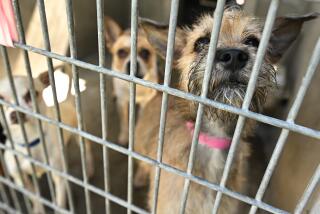In Wake of Raid, Shelter Defends Care of Wildlife : Animals: State officials allege ‘wildlife abuses’ at the San Gabriel Valley Humane Society. Center’s employees deny any wrongdoing.
- Share via
SAN GABRIEL — Workers and administrators at the San Gabriel Valley Humane Society and Wildlife Rehabilitation Center are still stunned by the raid there last month.
“It wasn’t a drug raid, but it sure seemed like one,” said veterinarian Don Needham.
On Jan. 26, armed state Department of Fish and Game wardens seized 21 animals and birds from the shelter, alleging “wildlife abuses.” They assembled the shelter’s animal handlers in a separate room, then proceeded to carry off, among others, an Arctic fox, a coyote, four raccoons, a deer, four hawks and seven desert tortoises. Most of the animals had been there for five years or more.
They did not remove any of the shelter’s 275 domestic animals.
The raid didn’t make sense, said Joan Coleman, director of the Humane Society, which serves eight San Gabriel Valley cities. The state agency has known for years about the wild animals housed there, she said.
“All they ever said was that this was one of the nicest places they’d seen,” she said.
But Fish and Game authorities, who are preparing misdemeanor charges against Coleman and her son, assistant director John Coleman, stick by their guns.
They say that wild animals were being held in cages that were smaller than the legal size limits; that the shelter was holding wild animals without a permit, and there was no licensed rehabilitator working to prepare wild animals for eventual release.
Fish and Game spokesman Curt Taucher said state wardens made a videotape of the shelter as evidence. “It’s pretty graphic,” he said. “It shows hawks in parrot cages. There’s a hawk with a five-foot wingspan in a cage that’s at most two or three feet wide. It shows layers of feces in the raccoon cage.”
The Colemans would face up to a year in jail and $1,000 in fines for each of five misdemeanor charges. The shelter itself is being denied formal recognition as a wildlife rehabilitation center, where injured wild animals can be treated.
Coleman said that although she had allowed her state permits to lapse in 1988, state officials had never intimated that her program was in jeopardy.
She added that the shelter had released many injured wild animals after they were treated and that Needham is a respected wildlife rehabilitator. But the animals seized by state agents were mostly “unreleasable,” too disabled or too tame to survive in the wild, she said. These included a one-eyed owl, a blind raccoon and a hawk with a damaged wing.
She said the state wardens arrived just as staff members were cleaning up. Hawks had been housed overnight in parrot cages to protect them from cold night air, she said. Their normal cage, an 8-by-10 cubicle, is outdoors, she said.
Coleman said the Fish and Game charges were “fraught with lies and secondhand hearsay.” She would not elaborate.
For the past 33 years, the Humane Society, which serves San Gabriel, Temple City, Monrovia, Azusa, Monterey Park, Glendora, West Covina and Covina, has been largely the handiwork of Joan Coleman, according to animal activists from the area.
In the loosely knit world of animal protection and animal activism, Coleman has developed a reputation among some as a strict administrator who is adept at squeezing profits out of a litter of kittens or a stray dog. One local veterinarian called her “ironhanded.”
The Society’s annual budget has averaged about $700,000 in recent years, almost 90% of it from the sale and servicing of pets. The rest is made up by contributions and grants.
There are 20 employees; according to tax forms obtained by The Times, only Coleman and her son earn more than $30,000 a year. In 1989, Joan Coleman earned $60,150, and her son got $47,689.
Veterinarians were generally reluctant to talk for the record about the shelter. One said the shelter had often done a poor job of weeding out sick kittens, for which the shelter charges $39.65, including vaccination fees and spaying or neutering charges.
“Those kittens are quite marketable,” said the veterinarian, who asked that his name be withheld. “That’s why they don’t like to destroy them. One lady I know went through three kittens (from the Humane Society) before she got a healthy one. The first two died. It was very traumatic.”
Coleman said that, though all animals are vaccinated against common diseases, there’s no way of screening for every ailment. “They may have been thrown out on the streets,” she said. “There’s no history on a lot of the animals coming in. We harbor them all.”
South Pasadena animal activist Maida Henderson, who represents various animal rescue groups, said smaller dogs at the shelter are sometimes housed with larger, more aggressive dogs, who leave them seriously injured. “They can get dragged around like a football,” she said.
But Coleman and Needham said that, as a policy, the shelter separated small and large dogs, which appeared to be the case during a recent tour. Needham added that all animals, young and old, were vaccinated against common dog and cat diseases.
Steve McNall, director of the Pasadena Humane Society, would not talk directly about his counterpart. But he said he disagreed with the notion of using disabled or tame animals for display. “I don’t believe that, for example, an eagle with one eye or one wing should be used as a decorative item, sitting in a cage for the rest of his life,” McNall said.
He said that the Pasadena facility generally destroyed wild animals that could not be rehabilitated.
A recent tour of the San Gabriel facility showed a mostly smooth-running operation, with fiberglass-floored kennels and a rear patio with an ambulating Shetland pony. Would-be adopters wandered past rows of howling dogs, and animal handlers cleaned out cages.
It was vaccination day at the shelter, and a long line of dog and cat owners stretched out the front door. They inched their way through the office, nudging Tabby or Rover down a passageway until they reached a medical room, presided over by Needham, a large, graceful man in a white lab coat.
The San Gabriel Valley Humane Society has a brigade of several dozen volunteers, some of whom responded vocally to state charges. “Those animals are well cared for,” insisted Jack Nelson, a member of Telephone Pioneers of America, an organization of current and former AT&T; employees who take animals for visits to convalescent homes and orphanages.
“Those raccoons were just babies when they were brought to the society,” he said. “One of the officers took three of them home with her and got up every hour to bottle-feed them. That’s the kind of caring people they have there.”
Jo Isenberg, a past president of Protectors of Animals, the principal volunteer group associated with the shelter, said the shelter has consistently refused to give animals to medical researchers and has made special efforts to find homes for older dogs and cats.
She defended the practice of keeping disabled wild animals alive. “Ask the hawk who’s had his wing shot off if he’d rather be alive or dead,” she said.
More to Read
Sign up for Essential California
The most important California stories and recommendations in your inbox every morning.
You may occasionally receive promotional content from the Los Angeles Times.










